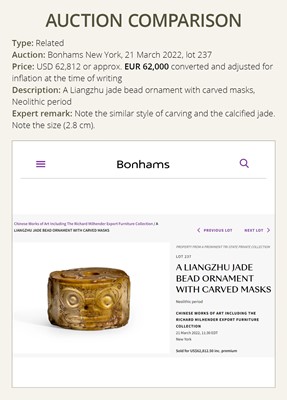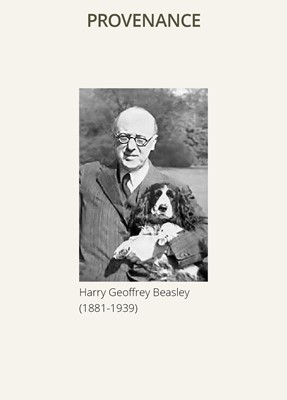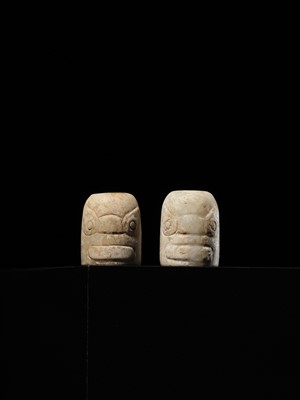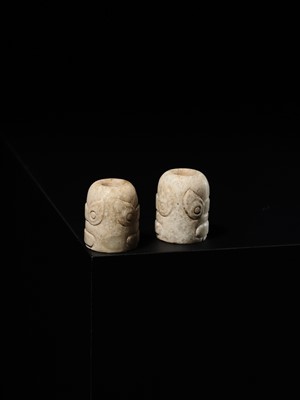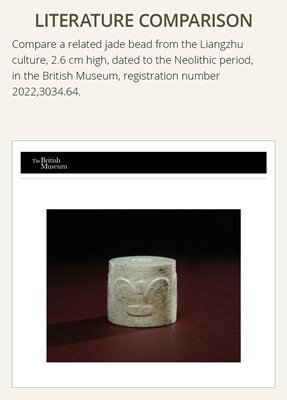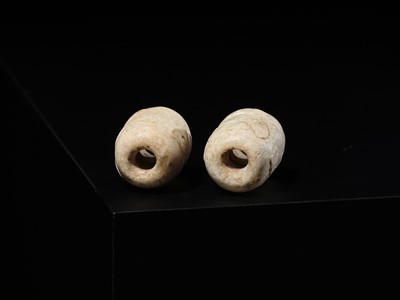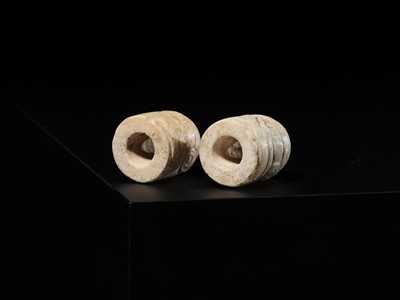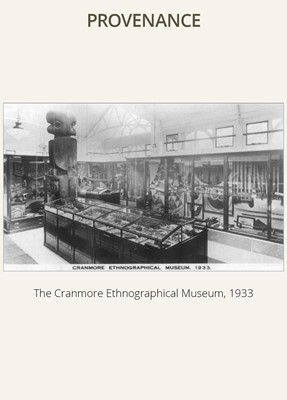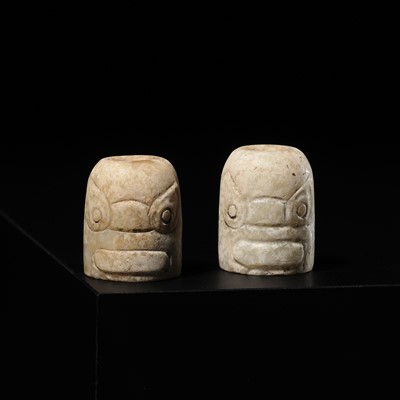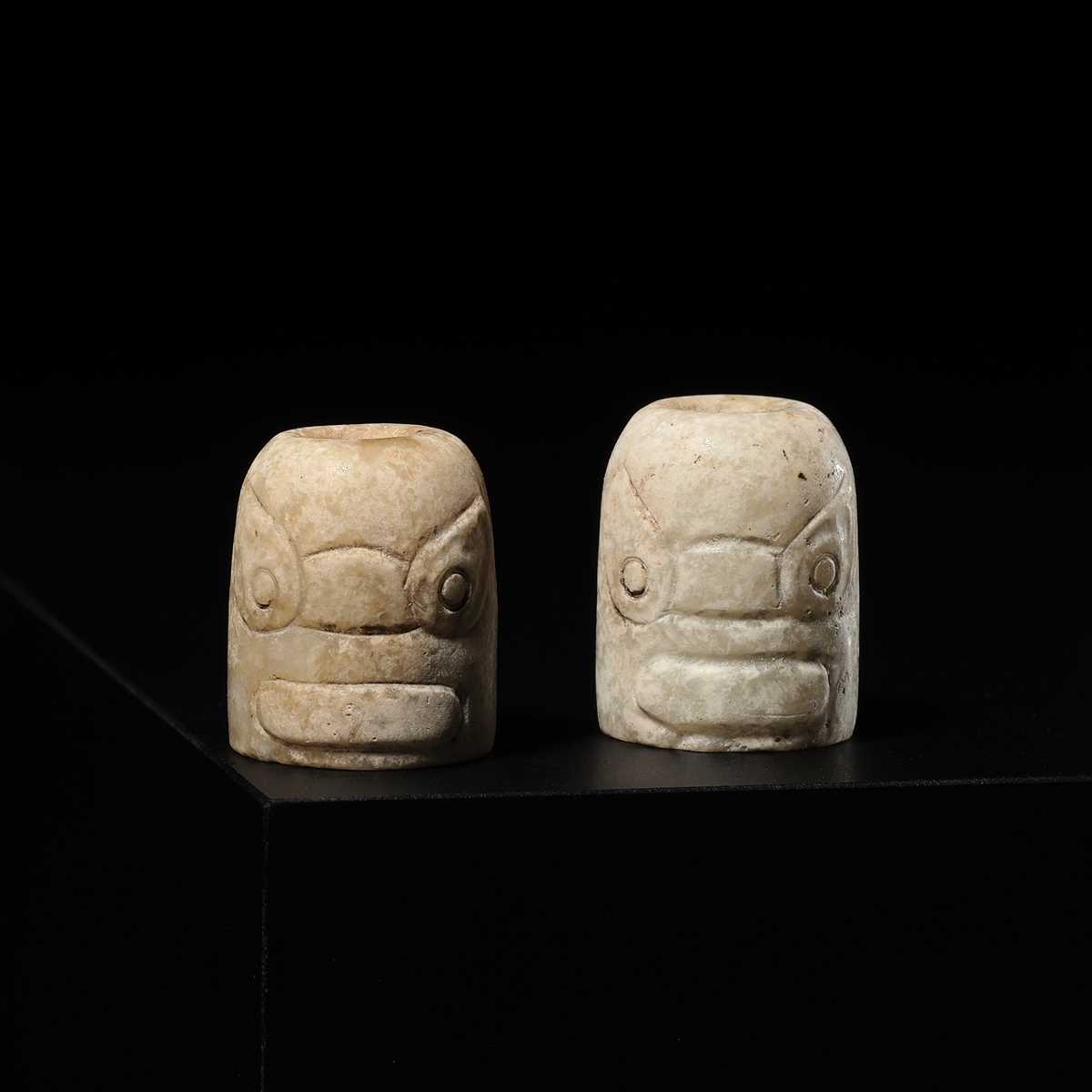1st Mar, 2024 10:00
The No Reserve Dragon Sale
37
A PAIR OF JADE BEAD ORNAMENTS WITH GODHEAD MASKS, SHENREN, LIANGZHU CULTURE
良渚文化一對神人獸面玉珠
Sold for €585
including Buyer's Premium
Please note this Lot is to be sold at No Reserve. 本拍品不設底價
China, circa 3300-2200 BC. The tubular beads are carved in a cylindrical form, tapered and rounded on the top and flat at the bottom, with two boldly incised masks, each with raised features, including teardrop-shaped eyes joined by a wide bridge above a bar-shaped mouth and a broad channel drilled from both ends. The opaque stone is covered entirely with calcified alteration, lustrous and ivory-white in color. (2)
Provenance: Collection of Harry Geoffrey Beasley and thence by descent to his widow Irene Beasley. Collection of Alfred William Cowperthwaite, acquired from the above c. 1939 and thence by descent in the same family. Harry Geoffrey Beasley (1881-1939) was a British anthropologist and museum curator who developed an important ethnographic collection during the early 20th century that is now held in various British museums. With his wife Irene, Beasley set up the Cranmore Ethnographical Museum which eventually held more than 6,000 objects of ethnographical interest. The Beasleys collected objects from across Europe, buying from auction houses and local museums to expand the collection, which contained material from the Pacific, Asia, Africa, and Northwestern America. Beasley wrote numerous articles for anthropological journals and was considered an expert in his field. He died in 1939 and his collection was stored with the British Museum collections during the war, which was fortunate, as the Cranmore Museum was destroyed by bombing. After the war, substantial portions of the collection were passed to the British Museum, the Royal Museum in Edinburgh, the Museum of Archaeology and Anthropology, the University of Cambridge, the Pitt Rivers Museum, and the Merseyside County Museum. Other pieces, such as the present lot, were sold by his widow and, after her death in 1974, by their daughters. Alfred William Cowperthwaite (1890-1964) was a contributor to the Cranmore Museum and became good friends with Harry Beasley. Shortly after Harry Beasley’s death, he acquired a number of objects from Irene Beasley, including the present lot.
Condition: Good condition, commensurate with age, with expected ancient wear, minuscule chips, some smoothened over time. The stone with calcifications, weathering and natural fissures, some of which have developed into small hairline cracks over time.
Weight: 4 g each
Dimensions: 1.7 cm and 1.6 cm
Please click here to read the full description
During the Neolithic period, especially within Hongshan, Liangzhu, and Longshan cultures, a large number of jade ornaments were buried with the elite. Beads like the one in this lot were worn along with headgear, knee decorations, elaborate necklaces, and other body ornaments all made primarily from jade. Dr. Elizabeth Childs-Johnson dubs these cultures a part of the ‘Jade Age,’ a period during which an abundance of jade objects accompanied the elite burials for the first time. The imagery on these adornments was highly standardized, and the most prominent image, which appears on this lot, is that of the godhead (also called a spirit person, shenren, or an anthropomorphized deity).
Literature comparison:
Compare a related jade bead from the Liangzhu culture, 2.6 cm high, dated to the Neolithic period, in the British Museum, registration number 2022,3034.64.
Auction result comparison:
Type: Related
Auction: Bonhams New York, 21 March 2022, lot 237
Price: USD 62,812 or approx. EUR 62,000 converted and adjusted for inflation at the time of writing
Description: A Liangzhu jade bead ornament with carved masks, Neolithic period
Expert remark: Note the similar style of carving and the calcified jade. Note the size (2.8 cm).
点此阅读中文翻译 (Chinese Translation)
良渚文化一對神人獸面玉珠
中國,西元前約3300-2200年。管狀珠子成圓柱形,頂部呈錐形和圓形,底部平坦,神人首面紋,在條形嘴上方有一個寬橋連接在一起,從兩端鑽出一條寬闊的孔。不透明的玉石完全被鈣化,表面有光澤,呈象牙白色。 (2)
來源:Harry Geoffrey Beasley (1881-1939)收藏,他逝世後由其遺孀Irene Beasley保存;Alfred William Cowperthwaite (1890-1964),約於1939年購於上述收藏,之後在同一家族保存至今。Harry Geoffrey Beasley (1881-1939) 是一位英國人類學家和博物館館長,他在二十世紀初建立了一個重要的民族志收藏,現在收藏在英國的各個博物館中。Beasley和他的妻子Irene一起建立了Cranmore民族志博物館,該博物館最終收藏了 6,000 多件民族志方面的物品。Beasley 收集了來自歐洲各地的物品,從拍賣行和當地博物館購買以擴大收藏範圍,其中包含來自太平洋、亞洲、非洲和美國西北部的資料。Beasley為人類學期刊撰寫了大量文章,被公認爲是該領域的專家。他於 1939 年去世,他的藏品幸虧在戰爭期間被存放在大英博物館裏,而Cranmore博物館被轟炸摧毀。戰後,大部分藏品被轉移到大英博物館、愛丁堡皇家博物館、劍橋大學考古與人類學博物館、Pitt Rivers博物館和Merseyside County博物館。其他收藏,例如現在的拍品,由他的遺孀出售,在她 1974 年去世後,由他們的女兒出售。Alfred William Cowperthwaite (1890-1964) 曾是Cranmore 民族志博物館重要支持人,也曾是 Harry Beasley的好友。在Harry Beasley去世不久,他從Irene Beasley 處購買了一些收藏,包括此件拍品。
品相:狀況良好,有磨損,微小磕損,有鈣化、風化和天然裂隙,有些隨著時間的推移已發展成細小裂紋。
重量:分別爲4 克( 每顆)
尺寸:分別爲1.7 與1.6 厘米
新石器時代期間,特別是紅山、良渚和龍山文化中,使用了大量的玉飾,屬於貴族階層裝飾品。它們與頭飾、衣服配飾、精緻的串珠項鍊和其他裝飾品一起佩戴,所有這些都主要由玉製成。Elizabeth Childs-Johnson博士將這些文化稱為“玉器時代”的一部分,在此期間,大量玉器首次伴隨著貴族階層墓葬。這些玉佩上雕刻的圖像非常標準化,而這批作品中最突出的圖像是神格(也稱為神人,或擬人化的神)。該圖像是平坦的,通常覆蓋雲紋,並具有結合鳥類和半人類元素的動物形態。
文獻比較:
比較一件相近的新石器時代良渚文化玉珠,高2.6 厘米,收藏於大英博物館,館藏編號2022,3034.64。
拍賣結果比較:
形制:相近
拍賣:紐約邦瀚斯,2022年3月21日,lot 237
價格:USD 62,812(相當於今日EUR 62,000)
描述:新石器時期良渚神面紋柱形玉飾
專家評論:請注意相似的雕刻風格和鈣化。請注意尺寸 (2.8 厘米)。
Please note this Lot is to be sold at No Reserve. 本拍品不設底價
China, circa 3300-2200 BC. The tubular beads are carved in a cylindrical form, tapered and rounded on the top and flat at the bottom, with two boldly incised masks, each with raised features, including teardrop-shaped eyes joined by a wide bridge above a bar-shaped mouth and a broad channel drilled from both ends. The opaque stone is covered entirely with calcified alteration, lustrous and ivory-white in color. (2)
Provenance: Collection of Harry Geoffrey Beasley and thence by descent to his widow Irene Beasley. Collection of Alfred William Cowperthwaite, acquired from the above c. 1939 and thence by descent in the same family. Harry Geoffrey Beasley (1881-1939) was a British anthropologist and museum curator who developed an important ethnographic collection during the early 20th century that is now held in various British museums. With his wife Irene, Beasley set up the Cranmore Ethnographical Museum which eventually held more than 6,000 objects of ethnographical interest. The Beasleys collected objects from across Europe, buying from auction houses and local museums to expand the collection, which contained material from the Pacific, Asia, Africa, and Northwestern America. Beasley wrote numerous articles for anthropological journals and was considered an expert in his field. He died in 1939 and his collection was stored with the British Museum collections during the war, which was fortunate, as the Cranmore Museum was destroyed by bombing. After the war, substantial portions of the collection were passed to the British Museum, the Royal Museum in Edinburgh, the Museum of Archaeology and Anthropology, the University of Cambridge, the Pitt Rivers Museum, and the Merseyside County Museum. Other pieces, such as the present lot, were sold by his widow and, after her death in 1974, by their daughters. Alfred William Cowperthwaite (1890-1964) was a contributor to the Cranmore Museum and became good friends with Harry Beasley. Shortly after Harry Beasley’s death, he acquired a number of objects from Irene Beasley, including the present lot.
Condition: Good condition, commensurate with age, with expected ancient wear, minuscule chips, some smoothened over time. The stone with calcifications, weathering and natural fissures, some of which have developed into small hairline cracks over time.
Weight: 4 g each
Dimensions: 1.7 cm and 1.6 cm
Please click here to read the full description
During the Neolithic period, especially within Hongshan, Liangzhu, and Longshan cultures, a large number of jade ornaments were buried with the elite. Beads like the one in this lot were worn along with headgear, knee decorations, elaborate necklaces, and other body ornaments all made primarily from jade. Dr. Elizabeth Childs-Johnson dubs these cultures a part of the ‘Jade Age,’ a period during which an abundance of jade objects accompanied the elite burials for the first time. The imagery on these adornments was highly standardized, and the most prominent image, which appears on this lot, is that of the godhead (also called a spirit person, shenren, or an anthropomorphized deity).
Literature comparison:
Compare a related jade bead from the Liangzhu culture, 2.6 cm high, dated to the Neolithic period, in the British Museum, registration number 2022,3034.64.
Auction result comparison:
Type: Related
Auction: Bonhams New York, 21 March 2022, lot 237
Price: USD 62,812 or approx. EUR 62,000 converted and adjusted for inflation at the time of writing
Description: A Liangzhu jade bead ornament with carved masks, Neolithic period
Expert remark: Note the similar style of carving and the calcified jade. Note the size (2.8 cm).
点此阅读中文翻译 (Chinese Translation)
良渚文化一對神人獸面玉珠
中國,西元前約3300-2200年。管狀珠子成圓柱形,頂部呈錐形和圓形,底部平坦,神人首面紋,在條形嘴上方有一個寬橋連接在一起,從兩端鑽出一條寬闊的孔。不透明的玉石完全被鈣化,表面有光澤,呈象牙白色。 (2)
來源:Harry Geoffrey Beasley (1881-1939)收藏,他逝世後由其遺孀Irene Beasley保存;Alfred William Cowperthwaite (1890-1964),約於1939年購於上述收藏,之後在同一家族保存至今。Harry Geoffrey Beasley (1881-1939) 是一位英國人類學家和博物館館長,他在二十世紀初建立了一個重要的民族志收藏,現在收藏在英國的各個博物館中。Beasley和他的妻子Irene一起建立了Cranmore民族志博物館,該博物館最終收藏了 6,000 多件民族志方面的物品。Beasley 收集了來自歐洲各地的物品,從拍賣行和當地博物館購買以擴大收藏範圍,其中包含來自太平洋、亞洲、非洲和美國西北部的資料。Beasley為人類學期刊撰寫了大量文章,被公認爲是該領域的專家。他於 1939 年去世,他的藏品幸虧在戰爭期間被存放在大英博物館裏,而Cranmore博物館被轟炸摧毀。戰後,大部分藏品被轉移到大英博物館、愛丁堡皇家博物館、劍橋大學考古與人類學博物館、Pitt Rivers博物館和Merseyside County博物館。其他收藏,例如現在的拍品,由他的遺孀出售,在她 1974 年去世後,由他們的女兒出售。Alfred William Cowperthwaite (1890-1964) 曾是Cranmore 民族志博物館重要支持人,也曾是 Harry Beasley的好友。在Harry Beasley去世不久,他從Irene Beasley 處購買了一些收藏,包括此件拍品。
品相:狀況良好,有磨損,微小磕損,有鈣化、風化和天然裂隙,有些隨著時間的推移已發展成細小裂紋。
重量:分別爲4 克( 每顆)
尺寸:分別爲1.7 與1.6 厘米
新石器時代期間,特別是紅山、良渚和龍山文化中,使用了大量的玉飾,屬於貴族階層裝飾品。它們與頭飾、衣服配飾、精緻的串珠項鍊和其他裝飾品一起佩戴,所有這些都主要由玉製成。Elizabeth Childs-Johnson博士將這些文化稱為“玉器時代”的一部分,在此期間,大量玉器首次伴隨著貴族階層墓葬。這些玉佩上雕刻的圖像非常標準化,而這批作品中最突出的圖像是神格(也稱為神人,或擬人化的神)。該圖像是平坦的,通常覆蓋雲紋,並具有結合鳥類和半人類元素的動物形態。
文獻比較:
比較一件相近的新石器時代良渚文化玉珠,高2.6 厘米,收藏於大英博物館,館藏編號2022,3034.64。
拍賣結果比較:
形制:相近
拍賣:紐約邦瀚斯,2022年3月21日,lot 237
價格:USD 62,812(相當於今日EUR 62,000)
描述:新石器時期良渚神面紋柱形玉飾
專家評論:請注意相似的雕刻風格和鈣化。請注意尺寸 (2.8 厘米)。
Zacke Live Online Bidding
Our online bidding platform makes it easier than ever to bid in our auctions! When you bid through our website, you can take advantage of our premium buyer's terms without incurring any additional online bidding surcharges.
To bid live online, you'll need to create an online account. Once your account is created and your identity is verified, you can register to bid in an auction up to 12 hours before the auction begins.
Intended Spend and Bid Limits
When you register to bid in an online auction, you will need to share your intended maximum spending budget for the auction. We will then review your intended spend and set a bid limit for you. Once you have pre-registered for a live online auction, you can see your intended spend and bid limit by going to 'Account Settings' and clicking on 'Live Bidding Registrations'.
Your bid limit will be the maximum amount you can bid during the auction. Your bid limit is for the hammer price and is not affected by the buyer’s premium and VAT. For example, if you have a bid limit of €1,000 and place two winning bids for €300 and €200, then you will only be able to bid €500 for the rest of the auction. If you try to place a bid that is higher than €500, you will not be able to do so.
Online Absentee and Telephone Bids
You can now leave absentee and telephone bids on our website!
Absentee Bidding
Once you've created an account and your identity is verified, you can leave your absentee bid directly on the lot page. We will contact you when your bids have been confirmed.
Telephone Bidding
Once you've created an account and your identity is verified, you can leave telephone bids online. We will contact you when your bids have been confirmed.
Classic Absentee and Telephone Bidding Form
You can still submit absentee and telephone bids by email or fax if you prefer. Simply fill out the Absentee Bidding/Telephone bidding form and return it to us by email at office@zacke.at or by fax at +43 (1) 532 04 52 20. You can download the PDF from our Upcoming Auctions page.
How-To Guides
How to Create Your Personal Zacke Account
How to Register to Bid on Zacke Live
How to Leave Absentee Bids Online
How to Leave Telephone Bids Online
中文版本的操作指南
创建新账号
注册Zacke Live在线直播竞拍(免平台费)
缺席投标和电话投标
Third-Party Bidding
We partner with best-in-class third-party partners to make it easy for you to bid online in the channel of your choice. Please note that if you bid with one of our third-party online partners, then there will be a live bidding surcharge on top of your final purchase price. You can find all of our fees here. Here's a full list of our third-party partners:
- 51 Bid Live
- EpaiLive
- ArtFoxLive
- Invaluable
- LiveAuctioneers
- the-saleroom
- lot-tissimo
- Drouot
Please note that we place different auctions on different platforms. For example, in general, we only place Chinese art auctions on 51 Bid Live.
Bidding in Person
You must register to bid in person and will be assigned a paddle at the auction. Please contact us at office@zacke.at or +43 (1) 532 04 52 for the latest local health and safety guidelines.



